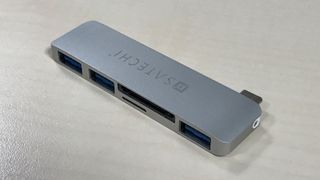How to expand your MacBook Pro with these essential accessories
Essentials to connect older peripherals
Non-Apple mobile devices
You can use a USB-C to USB-A adaptor with your existing cable, or obtain a replacement cable to go straight from USB-C to whatever kind of USB connector is on your mobile device. We mentioned various options of these types earlier.
Apple Watch and iOS devices with a 30-pin connector
Apple hasn’t introduced USB-C charging cables for Apple Watch or, of course, for iOS devices with the old 30-pin connector, but you can add a USB-C to USB-A adaptor such as Apple’s (as mentioned earlier for printers) to their cables.
iOS devices with a Lightning connector
A USB-C to USB-A adaptor can also be used with the Lightning to USB-A cable supplied with recent iOS devices – again, that’s appealing because you can reuse the adaptor with many other kinds of devices as well.
Alternatively, pick up a USB-C to Lightning cable; Apple’s come in 1m and 2m lengths, costing £19/US$19/AUS$25 and £29/US$29/AUS$45, respectively.
USB-C hubs
There are numerous USB-C docks to be found on Amazon and elsewhere. Many of them at the moment are limited to USB 3.1 Gen 1 speeds, but a maximum bandwidth of 5Gbps isn’t much of a limitation if you want a portable hub to carry with your MacBook.
With Gen 2-equipped computers just trickling out at the moment, you may want to wait if performance is an issue, or consider a Thunderbolt 3 hub (see below), once they ship.
Among our favourites, though, are two models from Satechi. Its inelegantly named Type-C Pass Through USB Hub with USB-C Charging Port packs in two USB-A ports and an SD card reader, and it affixes to the side of a 12-inch MacBook – not a problem there because it can’t exactly block any ports!
Satechi’s Type-C Slim Multi-Port Adapter sits at a short cable’s length away from your computer, making it the more suitable option if that’s a MacBook Pro. It also offers two USB-A ports and USB-C passthrough for power, but it lacks an SD card reader. In its place, though, it has an HDMI port, though it’s limited to a 30Hz refresh rate.
Satechi makes both of these hubs in the four colours Apple uses for many devices: Space Gray, Silver, Gold and Rose Gold.

Thunderbolt 3 docking stations
Soon after the 2016 MacBook Pro’s introduction, Belkin and OWC announced Thunderbolt 3 docks. Unlike USB-C hubs, these docks come with their own mains power supply, which doesn’t use USB-C, so they’re really intended to be permanently installed on your desk so you can connect a single cable to access all your devices.
Belkin’s Thunderbolt 3 Express Dock can connect eight devices through one port on your Mac, having ports for Gigabit Ethernet, 3.5mm audio outputs on its front and back, two USB-A (3.0) on the back and one on the front, passthrough Thunderbolt 3, and full-size DisplayPort. Its suggested retail price is £349.99 (US and Australian pricing TBC).
OWC’s dock has 13 ports: there’s an SD card reader, a combined audio input/output and a USB 3.1 Gen 1 port on its front, and four USB 3.1 Gen 1 port, S/PDIF optical output, FireWire 800, Gigabit Ethernet, passthrough Thunderbolt 3 and a Mini DisplayPort on the back. It’s suggested to retail for $299.95 (UK and Australian pricing TBC), and there’s a $20 preorder discount available through OWC’s site.
A spare charger
Apple’s USB-C power adaptors lack the anti-trip decoupling mechanism of its older MagSafe models, and the cable part is a separate purchase.
Together, they’ll set you back £68/US$68/AUS$104 for a 12-inch MacBook; £88/US$88/AUS$138 for a 13-inch MacBook Pro; and £98/$98/AUS$158 for a 15-inch MacBook Pro.
It’s not all bad news, though: if the cable gets damaged, it’s less wasteful and less costly to replace, being just £19/US$19/AUS$29 of those totals.
Be careful with third-party power adaptors and charging cables, especially where the 15-inch MacBook Pro is concerned: many already out there are rated to carry only up to 60W. Sadly, that includes Griffin’s desirable, MagSafe-esque BreakSafe charging cable (£29.99/US$39.99/AUS$48.99).

Networking over a cable
If you work somewhere Ethernet is mandatory for networking, or necessary due to Wi-Fi being poor or unavailable, you’ll need a USB-C to Ethernet adaptor. These are easy to come by.
Apple’s online store sells one of these from Belkin for £22/$26/$36.95. Other manufacturers make them too, of course, but you should also look at our later section on hubs, as some of those provide you with Ethernet alongside other expansion options.
Headphones
Headphones with a 3.5mm connector work with USB-C-equipped MacBooks right away, because Apple hasn’t got rid of the 3.5mm jack on them, like it has on the iPhone 7.
Sadly there’s no adaptor to go in the other direction and enable your iPhone 7’s EarPods with Lightning connector to plug in to a MacBook’s 3.5mm audio port, so you’ll need another set of headphones to use with your Mac.
Current page: Connecting phones, tablets and Apple Watch
Prev Page Connecting a printer or storage deviceGet daily insight, inspiration and deals in your inbox
Get the hottest deals available in your inbox plus news, reviews, opinion, analysis and more from the TechRadar team.
